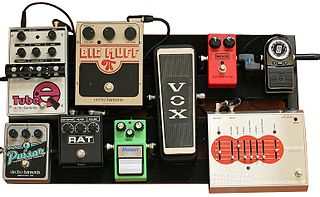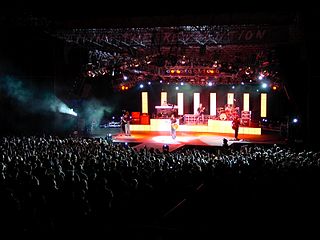Audio signal processing is a subfield of signal processing that is concerned with the electronic manipulation of audio signals. Audio signals are electronic representations of sound waves—longitudinal waves which travel through air, consisting of compressions and rarefactions. The energy contained in audio signals or sound power level is typically measured in decibels. As audio signals may be represented in either digital or analog format, processing may occur in either domain. Analog processors operate directly on the electrical signal, while digital processors operate mathematically on its digital representation.

An effects unit, effects processor, or effects pedal is an electronic device that alters the sound of a musical instrument or other audio source through audio signal processing.

Signal processing is an electrical engineering subfield that focuses on analyzing, modifying and synthesizing signals, such as sound, images, potential fields, seismic signals, altimetry processing, and scientific measurements. Signal processing techniques are used to optimize transmissions, digital storage efficiency, correcting distorted signals, improve subjective video quality, and to detect or pinpoint components of interest in a measured signal.

Digital audio is a representation of sound recorded in, or converted into, digital form. In digital audio, the sound wave of the audio signal is typically encoded as numerical samples in a continuous sequence. For example, in CD audio, samples are taken 44,100 times per second, each with 16-bit sample depth. Digital audio is also the name for the entire technology of sound recording and reproduction using audio signals that have been encoded in digital form. Following significant advances in digital audio technology during the 1970s and 1980s, it gradually replaced analog audio technology in many areas of audio engineering, record production and telecommunications in the 1990s and 2000s.
Dolby Digital, originally synonymous with Dolby AC-3, is the name for a family of audio compression technologies developed by Dolby Laboratories. Called Dolby Stereo Digital until 1995, it is lossy compression. The first use of Dolby Digital was to provide digital sound in cinemas from 35 mm film prints. It has since also been used for TV broadcast, radio broadcast via satellite, digital video streaming, DVDs, Blu-ray discs and game consoles.
Sound can be recorded and stored and played using either digital or analog techniques. Both techniques introduce errors and distortions in the sound, and these methods can be systematically compared. Musicians and listeners have argued over the superiority of digital versus analog sound recordings. Arguments for analog systems include the absence of fundamental error mechanisms which are present in digital audio systems, including aliasing and associated anti-aliasing filter implementation, jitter and quantization noise. Advocates of digital point to the high levels of performance possible with digital audio, including excellent linearity in the audible band and low levels of noise and distortion.

THX Ltd. is an American audio company based in the San Francisco Bay Area. It is known for its eponymous suite of high fidelity audiovisual reproduction standards for movie theaters, screening rooms, home theaters, computer speakers, video game consoles, car audio systems, and video games. The THX trailer that precedes compliant films is based on the Deep Note, with a distinctive glissando up from a rumbling low pitch.
Granular synthesis is a sound synthesis method that operates on the microsound time scale.

A sound reinforcement system is the combination of microphones, signal processors, amplifiers, and loudspeakers in enclosures all controlled by a mixing console that makes live or pre-recorded sounds louder and may also distribute those sounds to a larger or more distant audience. In many situations, a sound reinforcement system is also used to enhance or alter the sound of the sources on the stage, typically by using electronic effects, such as reverb, as opposed to simply amplifying the sources unaltered.
The Deep Note is the sound trademark of THX, being a distinctive synthesized crescendo that glissandos from a relatively narrow frequency spread to a broader frequency spread. It was created by James A. Moorer, a former employee of Lucasfilm's Computer Division in late 1982. The sound is used on trailers for THX-certified movie theaters, home video releases, video games, and in-car entertainment systems.

Sound recording and reproduction is the electrical, mechanical, electronic, or digital inscription and re-creation of sound waves, such as spoken voice, singing, instrumental music, or sound effects. The two main classes of sound recording technology are analog recording and digital recording.

Lexicon is an American company that engineers, manufactures, and markets audio equipment as a brand of Harman International Industries. The company was founded in 1971 with headquarters in Waltham, Massachusetts, and offices in Salt Lake City, Utah. It was acquired by Harman in 1993.
The EditDroid is a computerized analog non-linear editing (NLE) system which was developed by Lucasfilm spin-off company, the Droid Works and Convergence Corporation who formed a joint venture company. The company existed up through the mid-'80s to the early '90s in an attempt to move from analog editing methods to digital. EditDroid debuted at the National Association of Broadcasters (NAB) 62nd Annual meeting in Las Vegas in 1984 concurrent with another editing tool that would compete with the EditDroid for all its years in production, the Montage Picture Processor.
Sonic Studio is an American company manufacturing digital audio production tools for engineering professionals. The company was created when Sonic Solutions divested itself of its audio product lines in order to concentrate on DVD and multimedia–oriented products.
The SoundDroid is an early digital audio workstation designed by a team of engineers led by James A. Moorer at Lucasfilm between 1980 and 1987. It was a hard-disk–based, nonlinear audio editor developed on the Audio Signal Processor (ASP), a large-scale digital signal processor for real-time, multichannel equalization and audio mixing. The ASP was connected to a then-new SUN/1 workstation, and with a physical console, could replace multi-slider mixers and provide new tools for audio spotting, editing, and mixing.

In sound recording and reproduction, audio mixing is the process of optimizing and combining multitrack recordings into a final mono, stereo or surround sound product. In the process of combining the separate tracks, their relative levels are adjusted and balanced and various processes such as equalization and compression are commonly applied to individual tracks, groups of tracks, and the overall mix. In stereo and surround sound mixing, the placement of the tracks within the stereo field are adjusted and balanced. Audio mixing techniques and approaches vary widely and have a significant influence on the final product.
James Anderson Moorer is a digital audio and computer music engineer, responsible for over 40 technical publications and four patents.
Psychoacoustics is the branch of psychophysics involving the scientific study of the perception of sound by the human auditory system. It is the branch of science studying the psychological responses associated with sound including noise, speech, and music. Psychoacoustics is an interdisciplinary field including psychology, acoustics, electronic engineering, physics, biology, physiology, and computer science.
A click is a sonic artifact in sound and music production.
A reverb effect, or reverb, is an audio effect applied to a sound signal to simulate reverberation. It may be created through physical means, such as echo chambers, or electronically through audio signal processing. The American producer Bill Putnam is credited for the first artistic use of artificial reverb in music, on the 1947 song "Peg o' My Heart" by the Harmonicats.






